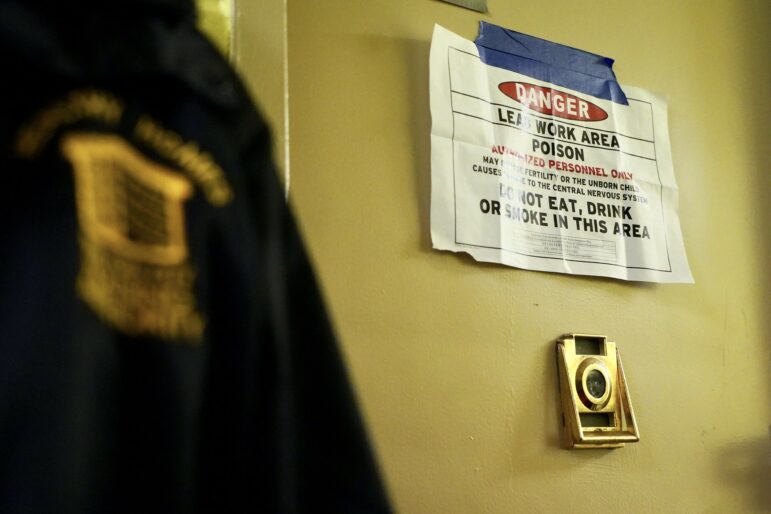
Photo by: Henry Gass
Fisherman on the Island Current. The changing mix of fish species in Long Island Sound may force changing the quota systems that regulate fishing there.
Carl Wills has been fishing in Long Island Sound for 58 years, and two months ago, for the first time in his life, he saw a sea turtle.
Working a night shift for a charter fishing company out of City Island in the Bronx, Wills, 61, was taking a moment to relax when the four-foot-wide turtle surfaced alongside the boat, the Island Current II.
“All of a sudden, this big thing comes out of the water and sticks its head up. What the hell?” says Wills, describing his reaction. “It was amazing to see that.”
Six species of sea turtle are found in U.S. waters, and they all usually dwell in the southeastern or Chesapeake Bay region. They are also not the only warm water animals to be living in Long Island Sound this fall.
Water temperatures in the Sound have been gradually rising for the past 30 years, a trend many area scientists attribute to global warming. Waters in the region around New York are warming faster than any other region in the country, and hit a record high this year on the eve of Hurricane Sandy. The trend threatens to destabilize a fragile marine ecosystem and the livelihoods of local fishermen already struggling to break even.
This year’s high water temperatures seem to be the result of an unusually warm winter persisting into the spring and summer months, according to scientists. They add that unseasonably high air temperatures are also coupled to the warming water.
The warming water in the region is disrupting traditional migration patterns, says Josh Kohut, an assistant professor in marine and coastal sciences at Rutgers.
“We’ve heard stories from guys out on the ocean that it’s just a really different ocean this year,” says Kohut.
Longer stays, new visitors
The waters around New York were already subject to some of the most dramatic annual temperate shifts, with ocean temperatures ranging from 40 degrees in the winter to 80 degrees in the summer. As a result, the region has always hosted some of the most migratory fish species on the planet.
And as hordes of fish clog New York’s waterways on their journeys north and south, Island Current customers drop their lines. Day trips get especially frenzied, with customers piling cold-adapted bluefish and warm-adapted sea robins up to their ankles.
Wills repairs houses on City Island during the day, skipping the fast-paced day fishing trips for the calmer night runs—his natural habitat. Night fishing is all about the long game. The slightest purr of a boat engine can startle a school, so one night a few weeks ago, the fishermen huddled inside their coats, watching their lines and murmuring fishing stories, flicking flaming cigarette butts into the salty night air.
The tranquility is broken when Wills gets hold of a recently-caught dogfish. The fish looks like a shark, and he grabs it by the tail and carries it around the small boat, his cigarette wagging between his stubbly gray beard, poking people with the creature and softly humming the “Jaws” theme music.
A warm-adapted species, dogfish are rarely caught this late in the fall, when they typically begin to migrate south. According to Kohut rising ocean warmth off the coast of New York are delaying the temperature triggers that prompt some fish migration. The trend has important consequences for local marine biodiversity.
“You would see a difference in the composition of species off our coast,” says Kohut. “I think there would be winners and losers.”
Who are the victors and the vanquished? Penny Howell, a fisheries biologist for the Connecticut Department of Energy and Environmental Protection has been studying 25 years of fishing catch reports for the Long Island Sound.
Howell found that warm-adapted species have grown in abundance in the Sound while cold-adapted species have declined. She notes, however, that the overall population and diversity of fish in the Sound has increased.
“We’re kind of gaining these mid-Atlantic species in slightly greater amounts and diversity than we’re losing the abundance of our usual cold-adapted species,” she says.
Howell adds that in a 25-year time frame her research showed a huge change in species diversity over just five years.
“Which was bigger than I thought it would be,” she says, considering the species that inhabit Long Island Sound are typically more resistant to temperature changes.
Debate over causes
Still, while scientists agree the warming trend is at least partly a result of human-induced global warming, they are quick to remind that they’re in uncharted territory. The science is young and the concrete, long-term consequences of the trend will only be understood through more research, they say.
Wills, like many other fishermen, doesn’t buy the climate change explanation.
“We never had a winter last year, so the water never got cold,” he says. “I don’t think it’s going to stay like that. We’ll have a cold winter and it’ll be back to normal, I hope.”
Warmer water holds less oxygen, meaning fish generally flee for cooler, more hospitable waters. The sea turtle wasn’t the only oddity Wills observed on the water two months ago. The bluefish his customers typically caught in droves that time of year were nowhere to be seen.
Earlier that summer, temperatures hit 80 degrees in Long Island Sound. Wills says cooler air made the water steam. Bunker fish floated to the surface, dead from the lack of oxygen.
Still, Wills is reluctant to blame global warming.
“I only see we had no winter this year, so strange fish are coming down. I might not see them again,” he says.
Instead, local fishermen are more worried about how shifting species migration could hurt their already struggling industry.
Regulations seen lagging
Mike Theiler, 47, has been a commercial lobsterman in Long Island Sound for over 20 years. He doesn’t think government fishery management, specifically quota-based management, is keeping pace with the changing marine population dynamics.
Regulations introduced in the late 1990s “compartmentalized” some fishermen, limiting the different species they were allowed to catch. Theiler says they have not been updated to account for the changing species populations.
“We’re bound by the quotas that were set back in the ‘90s when the range was not this far north,” says Theiler. “We should be allowed to harvest the fish that are here in abundance.”
Theiler gave the example of black sea bass, a species that has also only recently begun appearing in Long Island Sound.
“Connecticut should, in a perfect world, probably have four times the sea bass quota we have,” he says. “When [the quotas] were set we really didn’t catch that much sea bass, it didn’t bother us one bit. If I could keep that huge basket of sea bass I’m throwing back every day it would really change my bottom line.”
Theiler said the majority of fishermen in the area “are just scratching by.”
“If you have a major breakdown you’re in trouble, you’re in real trouble. We definitely need to take another look at the way we’re managing these migratory species,” he says.
Years ago, he says, “whatever was in abundance, we fished it. Now they’re trying to go back to that, but the horse is already out the barn.”
Various fisheries regulators are discussing changing the quota system, but instead of returning to old methods they are researching ways to incorporate the effects of global warming into how they assess fish stocks and assign quotas.
The popular solution is an ecosystem-based management program, as opposed to the current species-based program. Such a program would account for the effects of global warming, pollution, and human activity on the marine population, including changing migration patterns.
The species-based program, meanwhile, determines how much a population can be fished in reference to how fast the species can grow and reproduce with a fixed, and usually only roughly estimated, amount of mortality from other causes.
The New York Department of Environmental Conservation is one regulator exploring an ecosystem-based program. Steve Heins, a marine biologist with the department’s Division of Fish, Wildlife and Marine Resources, says the overhaul in management would likely take at least a year, and was worried the program wouldn’t get the level of support necessary to get off the ground.
“We’re just dividing existing resources into smaller and smaller pots, and if we go this way we’re going to need a lot of support from Congress and state agencies,” says Heins. “I’m a little worried, because it’s complex and it’s new, it won’t get the support.”
Theiler says regional politics are delaying potential changes to quotas even more. He says southern and mid-Atlantic states “are not about to give up a portion of the pie to us. It’s just not about to happen.”
Quotas can be changed through the regional councils and the Atlantic States Fisheries Commission. Heins notes that, in order to change quotas, New York would have to get several other states to vote with them.
“When you go to a council meeting and you have to convince everyone around you to vote your way, it’s pretty challenging,” says Heins.
Time to change course?
Many scientists accept the need to move slowly. They note that research on the effects global warming may be having in local waters dates only to the 1990s, a relatively short span for climate study.
Howell makes the argument that it’s in the best interests of fishermen to move slowly with the potential overhaul of the fishery management program.
“When you go into the situation where you’re determining people’s livelihood I think we have to be much more certain,” she says. “It’s much more important to be slow and correct than be quick and wrong.”
But others believe it’s unwise to delay action. John Manderson, a habitat ecologist with the National Oceanic and Atmospheric Administration, says it’s going to be “very difficult to have definitive conclusions,” and that at some point “we’re going to have to take precautionary action.”
Hurricane Sandy, he says, has added a sense of urgency to this call for change.
“You’re going to wait for us to tell you with 100 percent certainty this is happening?” he asks. “We can tell you with 100 percent certainty when it’s over.”








